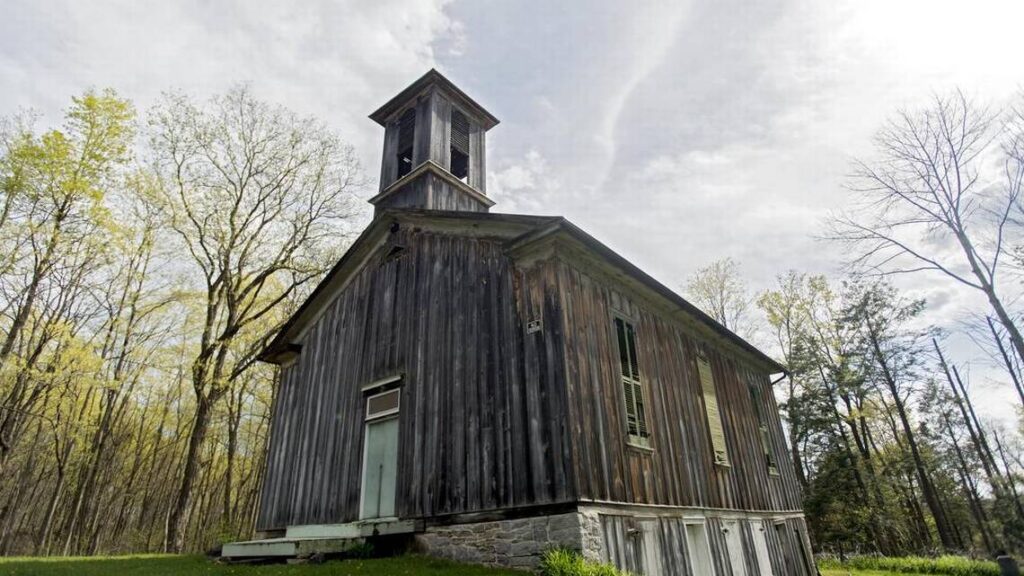Evangelical churches share common roots in the Protestant Reformation and later “awakenings” that established new denominations stressing personal salvation, holiness, Bible inerrancy, emotional worship, and simplicity. Settled during the Second Great Awakening (1780-1840), Centre County welcomed new denominations that blended both German and Scots Irish evangelical traditions.
Presbyterian churches were among the first religious organizations to be established in Scots Irish communities after an itinerant preacher, Philip Vickers Fithian, visited Colonel James Potter in 1775. Methodists and Baptists soon followed.
Methodism, based on the teachings of John and Charles Wesley, spread rapidly in the county after an itinerant preacher, David Coombs, paid a visit in 1787 to the home of Philip Antes in Bald Eagle, and the Benn-Pennington family near Linden Hall. Methodism offered a message of spiritual holiness and new birth to small “classes” served by traveling preachers.

United Brethren in Christ, a German offshoot of Methodism established by two German Reformed and Mennonite ministers, William Otterbein and Martin Boehm, was introduced to Centre County around 1802 by Christian Newcomer, who preached in both English and German. Another German Methodist group, the Evangelical Association, founded by Jacob Albright in 1800, began establishing congregations by 1804.
Baptists, dating to the 1600s in Europe, believed the Bible to be the only guide, and immersion baptism the only salvation. A Baptist missionary from Oneida, New York, visited the area in 1821, and baptisms in the Bald Eagle Creek were first reported in 1822.
Disciples of Christ grew out of the Stone-Campbell movement in Kentucky and western Pennsylvania that emphasized Christian unity and restoration of the New Testament church. Disciples established congregations in Howard and Beech Creek in the 1830s. Followers of William Miller, also known as Second Adventists, sent missionaries to Centre County in 1846 and built their first meeting house in 1849 in Boggs Township.
These evangelical denominations employed similar methods: itinerant preachers first met in individual homes or schoolhouses; circuit preachers then visited the scattered congregations; camp meetings attracted converts to large-scale revivals. As congregations grew, their original log churches were replaced by more formal structures. Many of these evangelical groups shared a commitment to social reforms, including antislavery and temperance.
After the Civil War, Dwight Moody, an evangelist who attracted thousands to his revivals, became an international figure. His dispensational doctrine – Biblical literacy, personal salvation, and Christ’s imminent return – became widely accepted. Unlike earlier evangelicals who supported social reform movements, Moody and others promoted conversion, not social reform, as the answer to poverty and social inequities. The Moody Bible Institute and the Niagara Bible Conference helped disseminate these ideas.
Linn’s History of Centre County, published in 1883, provides a snapshot of the churches in Centre County by township and borough, and documents the evangelical denominations flourishing in the mid 19th-century. The Adventists, now known as Messiah’s Church, found renewed interest in premillennialism and expanded to seven churches in the county. The Evangelical Association, United Brethren in Christ, Disciples of Christ as well as Baptists and Methodists, built churches throughout the county.

By the end of the 19th century, Protestant churches divided. Modernists embraced new scientific theories, such as evolution and historical interpretations of the Bible. Fundamentalists defended the doctrine of biblical inerrancy. Without centralized organizations, fundamentalist evangelical congregations adopted a diversity of practices that included foot-washing, plain dress, and pacificism.
Some congregations, like the Messiah’s Church Adventists, disappeared. New evangelical sects broke off and united with other groups. Protracted revivals, sometimes lasting weeks, were common. George E. Householder, pastor of the United Brethren Church of Bellefonte, was a frequent leader of these evangelistic services.
The Holiness Movement gave rise to other denominations within the Methodist tradition, including the Free Methodist Church, Wesleyan Church, Church of the Nazarene, and Pilgrim Holiness Church. God’s Missionary Church, founded in Pennsylvania in 1935, decided to charter a new denomination rather than join Pilgrim Holiness Church, Church of the Nazarene, or the Wesleyan Methodist Church. The related Pentecostal movement adopted charismatic practices such as “speaking in tongues” and faith healing. Pentecostal denominations include Assemblies of God and Church of God in Christ.
Today, many evangelical denominations, old and new, continue as active congregations in Centre County. In addition, historic structures and cemeteries associated with early evangelical churches remain as important local landmarks.
The Marsh Creek Advent Church, built by Adventists in 1849, and the Egg Hill Church, founded in 1838 by members of the Evangelical Association, are listed on the National Register of Historic Places. Regular services are no longer held at either church, but both host occasional special events.
Some former Evangelical and United Brethren churches now serve United Methodist congregations following the 1968 merger of the three denominations. While nearly every township has some record of an evangelical denomination, Boggs and Penn have the largest number of evangelical churches.
Without surviving church records, many of these evangelical denominations remain difficult to document. Historic burial grounds help locate early evangelical traditions throughout Centre County even where church buildings have been demolished. Cemeteries associated with Advent, Disciples of Christ, Evangelical Association, United Evangelical Brethren in Christ, and United Brethren denominations all attest to the legacy of Centre County’s evangelical past.
Barbara Franco
Sources:
Berkheimer, Charles, “Early Central Pennsylvania Methodism from Whitefield to Asbury,” 1968. https://www.lycoming.edu/umarch/chronicles/2003/2.berkheimer.pdf (Accessed October 12, 2023).
Linn, John Blair, History of Centre and Clinton Counties, Pennsylvania. Philadelphia: Louis H. Everts, 1883.
Loyer, Milton, “Centre County PA as a Microcosm of Early United Brethren Dynamics,” presented April 29, 2001 at annual meeting of the Central Pennsylvania Conference Historical Society at Trinity United Methodist Church, Bellefonte, PA.
Mitchell, J. Thomas. Centre County from its Earliest Settlement to the Year 1915. Penn State University Press, 2009
1877 Centre County, PA Church Affiliations http://pagenweb.org/~centre/church1877.htm (Accessed October 12, 2023).
Centre County Cemeteries http://pagenweb.org/~centre/graves.htm (Accessed October 12, 2023).
First Published: October 30, 2023
Last Modified: April 11, 2025
